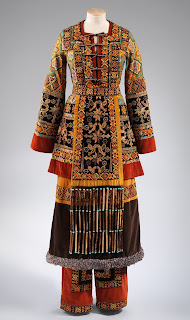 |
| Illustrating the Ancient Technique |
These small booklets of textile patterns, published regularly, in pocket-size with easy to-use patterns, were not made for library use, but became an instant success, essentially forming the first fashion publications.
These small reference books were the active use of their 16th-century owners across all levels of society. who were interested and invested in textile decoration as a means of self-expression and transformation of their household linens and ornamental design on dresses and ceremonial attire.
Unfortunately, in most cases, the instructions were made easier when users of the books tore out the pages and pasted or nailed them to workroom walls for inspiration. As a consequence many of these precious records of creativity were lost.
But not forever: the Metropolitan Museum of Arts exhibition FASHION and VIRTUE; TEXTILE PATTERNS and the PRINT REVOLUTION, 1520-1620 is a rare opportunity to view some of the amazing patterns that passed through the hands of homemakers and professionals who embellished textiles with the intricacy of design at a time when only human interpretation could realize the result. In an age when the computer governs design one can appreciate this art form with even more sensitivity for the vast volume of creativity that the exhibition displays. The collection drawn largely from the Metropolitan's own collection, combines printed pattern books, drawings, textile samples, costumes, paintings, and various other works of art to evoke the colorful world in which the Renaissance textile pattern books first emerged and functioned.
 |
| Leonardo da Vinci's Fifth Knot, Copy by Durer |
During the first quarter of the 16th century, the market for publications of textile patterns quickly expanded and the exchange of designs and ideas was established between Italy and the countries north of the Alps. The books became highly influential sources that both instructed and inspired many in the arts of making embroideries, weavings, and lace, as can be seen in surviving costumes and textiles of the period.
Throughout fashion history the urge to decorate, embellish and superimpose gave textiles beauty and were a testament to the instuitive talent of the women (and men) who interpreted designs into beautiful works of art.
The wide reach of these early publications meant that they were easily adapted for educational purposes, instructing women and young textile makers in the art while, like today's fashion magazines, they dispensed advice on proper conduct and a virtuous lifestyle.
 |
| Georgio Sanr'Angelo ensemble 1970 |
A runway of showcased garments highlights the incredible diversity of this textile art as interpreted in ancient garments that made highly diversified fashion statements through the intricacies of textile art. The exhibition also brings this art form full circle showing how designers interpreted this art form and made it their own fashion statement in red carpet collections.
Ta ta darlings!!! This exhibition is a tribute to the women (and men) who interpreted the intricacies of design. Fan mail welcome at pollytalknyc@gmail.com. Viisit www.pollytalk.com and in the right hand column select the link to the Blog that resonates with your interest.

No comments:
Post a Comment